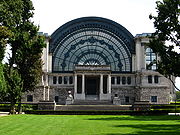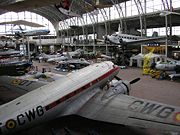
Royal Museum of the Armed Forces and of Military History
Encyclopedia

Museum
A museum is an institution that cares for a collection of artifacts and other objects of scientific, artistic, cultural, or historical importance and makes them available for public viewing through exhibits that may be permanent or temporary. Most large museums are located in major cities...
that occupies the two northernmost halls of the historic complex in Cinquantenaire Park
Cinquantenaire
Parc du Cinquantenaire or Jubelpark is a large public, urban park in the easternmost part of the European Quarter in Brussels, Belgium....
in Brussels
Brussels
Brussels , officially the Brussels Region or Brussels-Capital Region , is the capital of Belgium and the de facto capital of the European Union...
, Belgium
Belgium
Belgium , officially the Kingdom of Belgium, is a federal state in Western Europe. It is a founding member of the European Union and hosts the EU's headquarters, and those of several other major international organisations such as NATO.Belgium is also a member of, or affiliated to, many...
. The Dutch name is Koninklijk Museum van het Leger en de Krijgsgeschiedenis.
The building
In 1875, the Belgian architect Gideon Bordiau made a proposal to build flats on the site of an ancient marching ground of the Civil Guard.The layout of the park was set in the suburbs of Etterbeek
Etterbeek
Etterbeek is one of the nineteen municipalities located in the Brussels-Capital Region of Belgium. It neighbours the municipalities of the City of Brussels, Ixelles, Auderghem, Woluwe-Saint-Pierre, Woluwe-Saint-Lambert and Schaerbeek....
in 1888. Bordiau received the name of Cinquantenaire at that time in remembrance of the success of the Jubilee celebration of the independence of Belgium.
The construction of buildings, however, was put on hold in 1890 for lack of money and was eventually stopped by the death of the architect in 1904. Work resumed the following year under the direction of French architect Charles Girault
Charles Girault
Charles-Louis Girault was a French architect.Born in Cosne-Cours-sur-Loire, he studied with Honoré Daumet at the École nationale supérieure des Beaux-Arts in Paris. He received the first Prix de Rome, awarded him in 1880 on the basis of a design for a hospital for sick children along the...
and was completed with a new patron; King Leopold II. Arches that had already been planned were amended and expanded to meet the wishes of the King. The park is set on the continuation of the rue de la Loi / Wetstraat
Wetstraat
Rue de la Loi or Wetstraat is a principal road running through central and eastern Brussels which is famous due to the presence of several notable governmental buildings...
, which starts at the end of the Brussels Park before the royal palace.
A fire destroyed the south wing of the building in 1946.
History
At the exhibition of 1910, a section on military history was presented to the public and met with great success.Given the enthusiasm of the population, the authorities formed a museum of the army within the international context of extreme tension which led to the Great War. The museum was originally installed on the site of the Abbaye de la Cambre and moved to the Cinquantenaire Park site in 1923.
Collection
The collection originally consisted of a set of exhibits collected by an officer, Louis Leconte. Approximately 900 pieces were brought together, the collection was later heavily enriched by legacies, gifts and exchanges. Leconte was particular in choosing from equipment abandoned by the Germans in 1918.Today, it is possible to find uniforms, weapons, vehicles and military equipment of all ages and all countries.
Important developments include:
- 1980 — opening of the armour section
- 1986 — armour collection moved from the northernmost hall
- 1996 — opening of the marine section
Aviation hall

The collection includes various types of aircraft, some dating back to the beginning of the twentieth century. The collection is one of the largest in the world.

